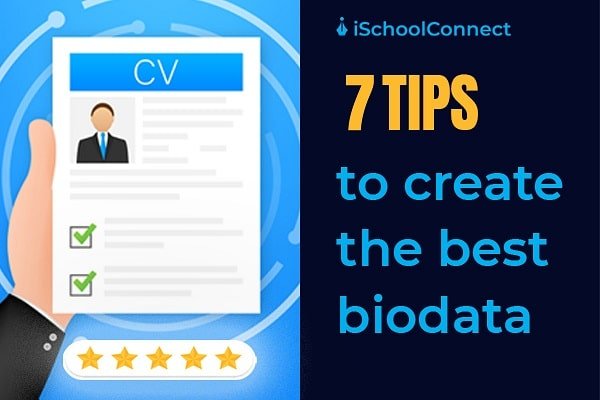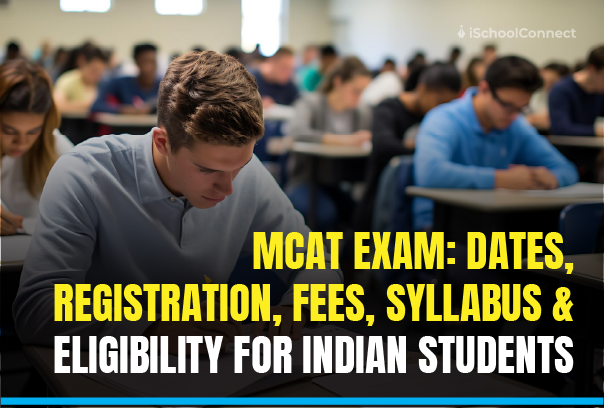Table of Contents
Biodata | An introduction
Nowadays, most universities require the submission of biodata along with a statement of purpose and related academic documents. Therefore, as a student, you may need it for higher education. However, most students are often confused about the proper biodata format. If you have similar concerns and want to know how to create biodata that stands out, you will first need to understand what it is and its different purposes.
What is Biodata?
By definition, a biodata is the biographical data of a person’s life and experiences. Such an account can include personal, academic, and career information. It may contain your personal information, like name, date of birth, nationality, and more. Further, it includes information about your academic qualifications and work experiences. So, what kind of information to input? Depends on the type you are preparing.
Types of Biodata
You may need a biodata for applying to a job or a university, and hence these two are the most prominent types:
1. Employment
While biodata is no longer a necessity by most employers, it was the single most important document for job applications a few decades ago.
You may notice some employers still asking for a biodata, but it is generally accompanied by a resume. Although you might not need it for a job anymore, it is still an important document for college applications.
2. Education
Compared to the requirement for employment, colleges expect a rather simple biodata format that includes certain basic personal details and physical attributes.
It is merely a record of who you are and what you like to do. If you want to know how to write an application for college, then we recommend you spend some time in self-reflection.
In doing this, you will be able to jot down the most important attributes that are worth mentioning to your prospective college.
How to prepare a biodata?

Writing a biodata is not as complicated as it may seem at first. You just need to follow a step-by-step process to ensure that your application truly stands out amidst the several hundred submitted to your desired university. This simple 7-step guide will solve all your doubts.
1. Honesty
The first and foremost thing you need to remember is to be honest. Notably, honesty is highly valued by both colleges and employers.
In today’s connected world, it is not very difficult to verify all the details you mention. Most colleges and employers perform background checks on their candidates through their social media activities or valid references. With an honestly written biodata and powerful statement of purpose, you will have great chances to get accepted at the university of your choice.
2. Personal details
This is the first section, as it gives an overview of a candidate. If you believe in the first impression being the last impression, you need to formulate this part perfectly.
While you may find various samples online, do some research on your workplace or college to see which format they like. It will assist you in filtering your reference research and save you time.
The personal details section of this document essentially consists of your full name and current age, along with your updated contact information.
3. Educational background

The next part should emphasize your educational background. This includes the latest educational qualification (school, diploma, certificate, graduation, or post-graduation). When applying to colleges and universities, it is best to provide the grades of your latest exams as well.
Moreover, you can mention any other certifications you may have achieved during your education. Do not include any extra or co-curricular certifications in this section.
4. Achievements
When creating an online biodata as well as an offline one, you must never forget to mention the most prominent achievements during your academic life.
When applying for a diploma or a graduate course, you will have to provide certificates of your achievements during your school days. What is interesting about this is that you may include both co-curricular and extra-curricular achievements in this section.
Since many universities and employers value these as attributes that make a candidate more desirable, you will have to be quite specific when writing about your achievements.
5. Essential Skills
For some employers and colleges, this is the most important section because it clearly identifies what you, as a candidate, can and cannot do. Therefore, you need to be extra cautious with this part. One way to do this is first to jot down all your personal and professional skills and briefly describe each.
6. Proofread
Finally, the last step is to proofread and ensure there are no grammatical, spelling, or formatting errors. A biodata with such errors does not speak well of the applicant. You can safely submit a well-polished record of your details and create an impression on either a prospective employer or college.
7. Appendices
A biodata is incomplete without an appendix of your educational documents. This is an optional step but is highly recommended, especially for students who wish to enroll themselves in prestigious universities. This means when applying for a graduate program, you will have to attach your high school mark sheet along with your biodata. Similarly, when applying for a postgraduate program, you will have to attach your graduation mark sheet along with your biodata.
This step-wise creation will definitely give you a competitive edge. Let’s look at a simple template to get an idea of how to create one.
A simple biodata template
The template given below is most suitable for a college or a university but can also be used as a biodata format for a job application.
Name:
Age:
Contact Information:
Educational Details:
| Year of Passing | Qualification | Subject of Specialisation | School/College/University Name | Total Grade % |
| SSC/ 10th/ Other | ||||
| HSC/ 12th/ Other | ||||
| Graduation | ||||
| Post Graduation | ||||
| Others |
Professional Experience:
| Duration/Year | Organization | Job Title | Job Description |
Achievements:
| Achievement | Description |
Things to remember

Even with the 7-step process and a template, you may have a few apprehensions related to the role of a biodata, resume, and curriculum vitae. So, here are a few things to remember that will help you differentiate among them.
- The term biodata is often used interchangeably with resume and curriculum vitae (CV). Although a biodata can be a part of a resume, it can never be vice-versa.
- A biodata is simply a record of personal details like name, age, ethnicity, and contact information, whereas a resume is job-oriented and can be different for an individual applying for different types of jobs.
- A biodata is also different from a CV because the former is generally one to two pages long, whereas there is no page limit for a CV.
Read more: How Does AI Solve Pain Points of the Traditional Enrollment Process?
Key takeaway
- With a well-written biodata, you effectively have an upper hand in the competition for both education and employment.
- Follow the 7-step process so that you do not have to rely on the biodata sample available online.
- Remember the important rules and instructions mentioned by your university to avoid rejections.
If you are still not sure about the university or job application processes or want to apply for a university abroad, reach out to us. We will help you with the process and make your application stand out.
Like this blog? Then read: How to study smart for exams
FAQs
Q1. Should a biodata be handwritten or printed?
Answer- Nowadays, handwritten biodata is usually not accepted anywhere. Therefore, you need to have a printed one.
Q2. Should a biodata contain a passport-sized photograph?
Answer- Such a photo is usually required for a resume or CV more than in a biodata, but there are no rules that say you cannot attach one in your biodata as well.
Q3. When applying to a university abroad, what other documents should accompany a biodata?
Answer- In such cases, it should be accompanied by a statement of purpose, letter of recommendation, scores of tests like IELTS, TOEFL, GRE, or GMAT, and an essay (optional).
O4. Why have the terms resume and CV become synonymous with biodata?
Answer- A resume is a preferred term used in the United States, while CV is used in the United Kingdom. Due to recent professional exchanges and globalization, CV, resume, and biodata are sometimes used synonymously in India.






